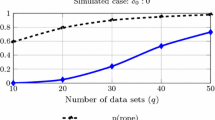Abstract
A model is presented for evaluating potential effectiveness of a Bayesian classification system using the expected value of the posterior probability for true classifications as an evaluation metric. For a given set of input parameters, the value of this complex metric is predictable from a simply computed row variance metric. Prediction equations are given for several representative sets of input parameters.
Similar content being viewed by others
References
Chernoff, H. and Moses, L. E.Elementary decision theory. New York: Wiley, 1959.
Edwards, W., Lindman, H. A., and Savage, L. J. Bayesian statistical inference for psychological research.Psychol. Rev., 1963,70, 193–242.
Southard, J. F., Schum, D. A., and Briggs, G. E. An application of Bayes theorem as a hypotheses-selection aid in a complex information-processing system. Wright-Patterson AFB, Ohio. Behavioral Sciences Laboratory: (AMRL-TDR-64-51), 1964.
Author information
Authors and Affiliations
Rights and permissions
About this article
Cite this article
Herman, L.M., Dollinger, M.B. Predicting effectiveness of bayesian classification systems. Psychometrika 31, 341–349 (1966). https://doi.org/10.1007/BF02289467
Received:
Revised:
Issue Date:
DOI: https://doi.org/10.1007/BF02289467




